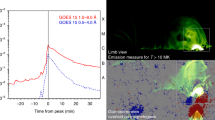Abstract
It is commonly assumed that, after the impulsive stage of a solar flare, hot (Te ≈ 107 K) plasma fills a magnetic flux tube and subsequently cools by both conduction to the chromosphere (where the temperature is about 104 K) and radiation (see, e.g., Phillips 1992; Dennis and Schwartz 1989). On the “chromospheric evaporation” picture, the hot plasma is formed by the heating of non-thermal particles that are accelerated during the impulsive stage, travel down the loop legs and impact against the chromosphere where the amount of energy released is too large to be radiated away so convection of the heated chromospheric gas occurs. This paper describes a computer simulation of the later, thermal phase of a solar flare in which the heated gas cools by conduction and radiation, allowing for the possibility of further, continuous heating. The resulting computer program, Hyperion 95, combines analysis and visualization capabilities that allow the flare to be viewed as with an X-ray telescope.
Access this chapter
Tax calculation will be finalised at checkout
Purchases are for personal use only
Similar content being viewed by others
References
Acton, L. W., Feldman, U., Bruner, M. E., Doschek, G. A., Hirayama, T., Hudson, H. S., Lemen, J. R., Ogawara, Y., Strong, K. T., and Tsuneta, S. (1992) Pub. Astron. Soc. Japan, 44, L71.
Dennis, B. R. and R. A. Schwartz (1989) Solar Phys., 121, 75.
Kopp, R. A. and Pneuman, G. W. (1976) Solar Phys., 50, 85.
Phillips, K. J. H. (1992) Guide to the Sun, Chapter 6. Cambridge University Press.
Raymond, J. C., Cox, D. P., and Smith, B. W. (1976) Astrophys. J., 204, 290.
Author information
Authors and Affiliations
Editor information
Editors and Affiliations
Rights and permissions
Copyright information
© 1996 Kluwer Academic Publishers
About this chapter
Cite this chapter
Hanoun, G.A., Phillips, K.J.H. (1996). Computer Simulation and Visulization of Solar Flares. In: Uchida, Y., Kosugi, T., Hudson, H.S. (eds) Magnetodynamic Phenomena in the Solar Atmosphere. Springer, Dordrecht. https://doi.org/10.1007/978-94-009-0315-9_153
Download citation
DOI: https://doi.org/10.1007/978-94-009-0315-9_153
Publisher Name: Springer, Dordrecht
Print ISBN: 978-94-010-6627-3
Online ISBN: 978-94-009-0315-9
eBook Packages: Springer Book Archive




